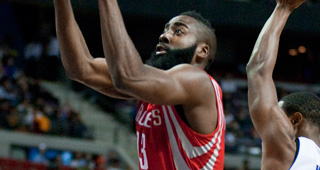A few days ago, Tim Kawakami wrote a piece trying in a way to refute Bill Simmons’ assertion that the Golden State Warriors turned down a potential deal to get James Harden this summer. While his heart appears to have been in the right place, some of the words he chose provide a glimpse into a larger underlying problem.
Kawakami wrote that: “[t]he turned-down-Harden part of it is not correct because, at least for the Warriors, that was a practically impossible deal to put together and OKC almost certainly knew it when they called the Warriors.”
Unfortunately, there are a few problems with this argument. The biggest one is that a potential trade built around Klay Thompson and James Harden was eminently possible and there could have been sufficient ground for a workable trade depending on how each team valued the potential assets.
First, a little background on one relevant piece of this issue. The NBA has a restriction in place called the Stepien Rule named after disastrous Cleveland Cavaliers owner Ted Stepien who traded seven high picks for six drafts (despite only owning the team for four years) with some of those picks being used to take James Worthy, Dennis Rodman and Detlef Schrempf. As a consequence, the league created the Rule that is usually articulated as a team cannot trade first round picks in consecutive years. However, the true nature of the restriction is that a team cannot potentially be without a first round pick two years in a row- acquiring a first round pick from another team via trade works fine. The other big factor that affects the Warriors is that it only works on draft picks and only looks to the future.
In the case of Golden State here, the argument was that their previous commitment to potentially move their protected 2013 first round pick to the Utah Jazz prevented them from trading their 2012 selection before the 2012 Draft due to the Stepien rule. However, the team had one workaround due to the fact that since the rule only looks to the future, once a player was chosen the restriction does not apply and he can be traded just like any other asset in the CBA.
However, there is an even bigger mistake that Kawakami made when making this case: by virtue of acquiring the 2012 first round pick from the San Antonio Spurs in the Stephen Jackson / Richard Jefferson trade, the team gave themselves two selections in the same draft, allowing them to move one of them before, during, or after the 2012 Draft without violating the Stepien rule. As such, the Warriors could have done a deal for Harden including either the No. 7 or No. 30 overall pick any time during that offseason.
With that out of the way, Kawakami’s other argument is a financial one. He wrote that Harden’s likely max extension “couldn’t fit into any kind of cap situation unless they were off-loading either Richard Jefferson or Andris Biedrins’ deal in the process.”
While the team would not have had a substantially different payroll in 2012-13, the team’s outstanding commitments to players like Andrew Bogut, David Lee, Andris Biedrins and Richard Jefferson combined with Harden’s big extension surely would have put Golden State over the luxury tax for that season. Kawakami is completely right on those narrow grounds but the problem is that this would only be a one-year condition that could then be remedied by the team and the team will be over the tax anyway next season- it just would have been a bigger one-time bill.
The trade would have worked under the CBA and then posed a financial burden for a grand total of one season and then largely resolved itself. With more than $20 million coming off the books for players barely making a dent in the rotation, the team would then have a financial commitment base of Harden, Curry, Lee and Bogut with no other player making more than the mid-level. The organization would eventually need to make hard choices on the big men, but would actually have a little more time since Thompson and likely the first round pick that season would not be up for extensions near then since they would not be on the team anymore. A one-year hit certainly seems like a barrier for a trade of this magnitude.
Furthermore, Kawakami responded to me on Twitter after my initial response that this would have pushed the timeline up significantly on OKC and Harden coming to an understanding. Unfortunately for him, the far more substantiated reports of Thunder GM Sam Presti offering to move The Bearded One to the Wizards for the No. 3 overall pick before the draft show the willingness to negotiate and make the best deal months before they ended up pulling the trigger. Furthermore, it makes sense that the Thunder had a good idea where Harden stood on an extension early enough to see the eventual impasse and make the best move for the franchise.
Now, I want to be perfectly clear that I am not saying I necessarily would have made the trade that Simmons talked about in his piece, especially at the time. However, arguing that the Warriors should or should not have taken the deal that Oklahoma City may have offered is wholly different than asserting that no serious deal was possible when it unambiguously was. While under the rules of the current Collective Bargaining Agreement, organizations have to be willing to consider any and every possible avenue to improve their team even if they end up standing pat or going another direction. As writers covering and analyzing those decisions, we owe it to the discourse and to the fans to do so both honestly and accurately.



